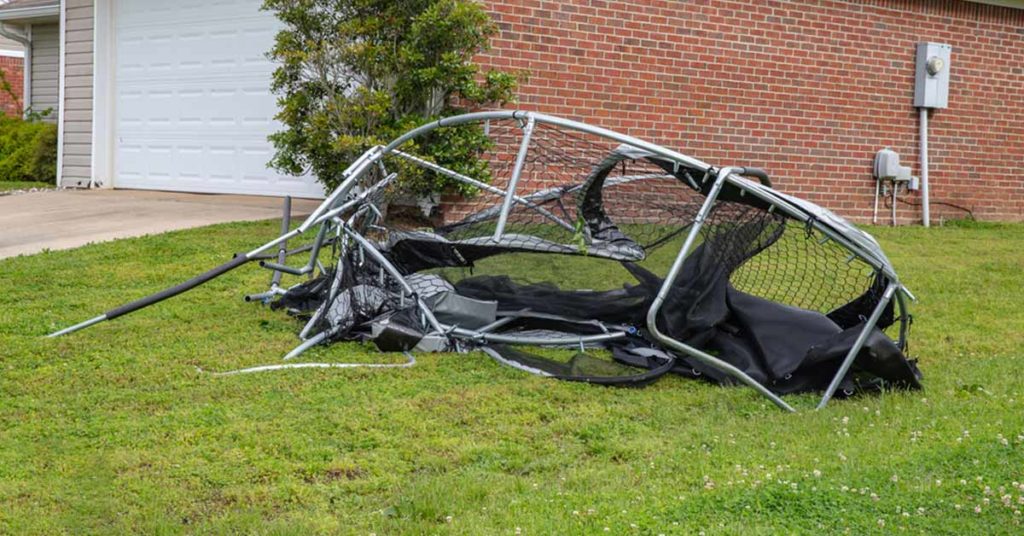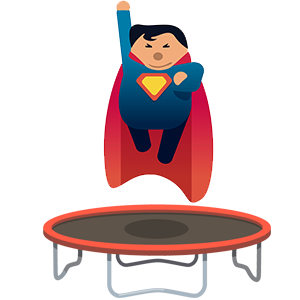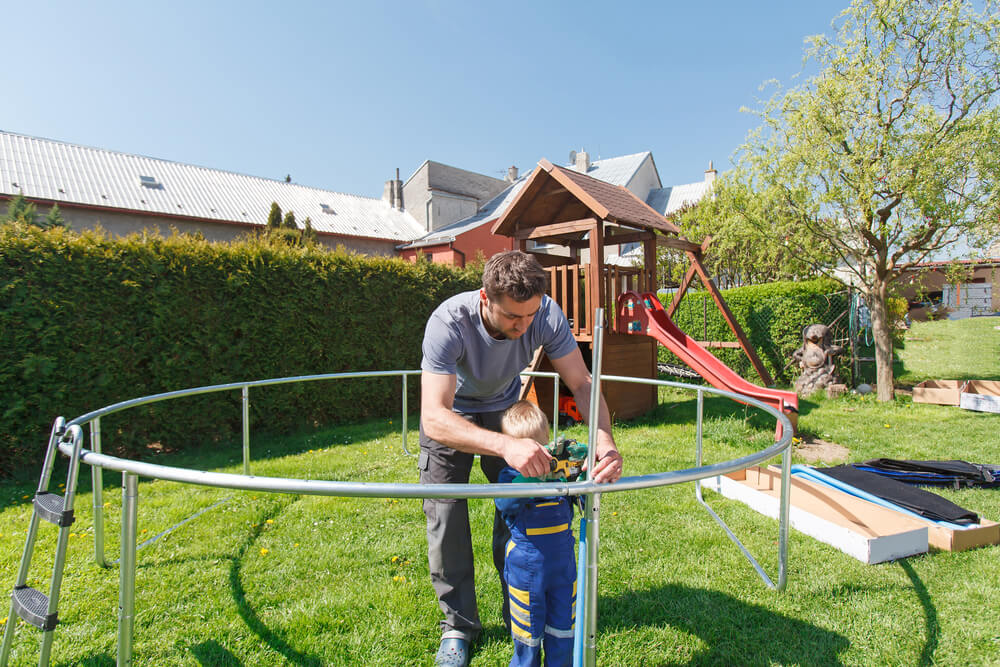While trampolines are a great way to have fun and exercise, they can break. What can make a trampoline break? And can you do anything to save your unit from breakage? Read on to learn more.
One of the questions readers keep emailing us is, can a trampoline break?
Yes, a trampoline can break.
Despite trampolines being fun and exercise tools, always bear in mind that they can break.
Frames collapse, mats rip, and springs overstretch or get undone, which causes trampolines to break.
But the good news is, you can avoid this by taking the necessary precautions to add more years to your unit.
Ready to know what may make your rebounder break down and how you can prevent it?
Keep reading.
What Causes Trampolines to Break?
Trampolines do break, and in different ways.
Check them out below:
1. Low-Quality Frames
The frame is the support system of the trampoline. It needs to be solid and sturdy; otherwise, the trampoline doesn’t have a solid base which is crucial for its functioning.
Also, with a weak base, the legs, after some time, will start to bend and, in the end, collapse.
However, a trampoline with a solid and robust frame should endure a beating without the base shifting or bending while in use.
Trampolines with high-quality frames come at a price, but if you value the safety of those using them, you won’t mind sacrificing a few more bucks to secure it.
In addition, poor-quality trampolines with weak frames don’t last that long, and I bet a trampoline is the last thing you want to keep replacing.
So, when purchasing a trampoline, do your due diligence to only get a model whose frames are made from high-quality, durable material.
2. Poor Jumping Mats
The jumping mat is as essential to a trampoline as it gets. In other words, no jumping mat, no trampoline.
It is the surface on which you bounce or land. The component also takes the most beating on a trampoline.
UV rays from the sun, frequent jumping, and chilly conditions cause wear and tear to the mat.
How to prevent that?
Check the jumping mat before and after use. Immediately you notice a hole on the jumping mat, fix it to prevent it from widening.
It is advisable to keep your trampoline in the shade during hot weather so that the mat doesn’t wear out. Additionally, during winter, ensure that you cover it up.
If your trampoline is frequently used, consider changing the jumping mat after 2-3 years of use.
3. Overstretched/Over Sprung and Missing Springs
Springs are another component of a trampoline that can cause it to break. They are mostly made of galvanized steel wire.
Although they are made of steel, they can wear out faster than you may think and result in trampoline breakage.
When you constantly jump on a trampoline, the springs gradually lose their elasticity, affecting the trampoline’s bounce.
Never use a trampoline if some springs are missing or overstretched. The remaining springs will have to absorb the extra load that the missing or overstretched used to take up. Over time, the risk of the jumping mat tearing increases as the remaining springs will succumb to the extra load’s force.
But there’s a remedy to this,
To check whether your springs need to be replaced? Do this,
- Remove the springs from your trampoline.
- Clasp a spring in your arm and grasp one end. Check the tightness of the spring by shaking it.
- When you release the spring, and it fails to recoil into its tight natural state, it means it is overstretched.
Undertake this test on at least a dozen of the trampoline’s springs. This is because testing more springs gives a better picture of the safety of the whole trampoline.
Springs are among the most affordable parts of a trampoline; actual replacing is also quite simple to learn. You just have to ensure you get the same spring size whenever you order replacements.
Also, ensure that the springs have padding on them. Your kid’s little legs could be stuck in there during jumping, and it can be severe in some cases. Padding also keeps off the rust.
4. Please, Do Not Exceed The Trampoline’s Weight Capacity
Every trampoline has a minimum amount of weight it can support. That is its weight capacity. Beyond that capacity, the trampoline is likely to break.
Why do you need to know your trampoline’s weight capacity?
You see, back in the day, trampolines were built for kids only. Rarely would you find adults jumping on them.
These days, that idea is long gone.
Kids and adults alike worldwide are familiar with trampolines and find them super enjoyable and relaxing.
So, that being said, you don’t want to find yourself in a situation whereby you or any adult around would wish to jump a bit, but the trampoline’s weight capacity is suited only for your kids.
Please don’t do it, though, regardless of the desire because it is dangerous.
The weight capacities of trampolines are there for a reason – to ensure the equipment operates efficiently with breaking.
All trampolines should be able to return the downward force exerted onto them with the same upward force.
But wait, there’s more!
Trampolines made for heavier people will not be that much enjoyable when used by lighter-weight people. The downward force they exert is not heavy enough to generate the equivalent upward force.
On the other hand, if heavier people use a trampoline made for lighter-weight people, it will most likely break as the force exerted downwards exceeds the maximum that the trampoline can bear.
It is really worth ensuring you know the weight capacity of your trampoline when purchasing and desist exceeding it.
We have a general idea for you:
- 8-10 foot trampoline’s weight capacity is 150-250 pounds.
- 12-foot trampolines’ weight capacity is 250-300 pounds.
- 14-foot trampolines’ weight capacity goes up to 350 pounds.
- 15-16 foot trampoline weight capacity goes up to 400 pounds.
By now, you know how and why trampolines break.
But, do you prevent a trampoline from breaking?
7 Easy Tips to Keep Your Trampoline from Breaking
The open secret is maintenance. Maintenance of any equipment is a tried and proven method to increase longevity and reduce chances of malfunctions and, in this case, breakage of a trampoline.
Below are the open secrets.
1. Keep a close eye on your trampoline to detect issues before they get out of hand.
2. Cover your trampoline when not in use. It shields it from harmful UV rays from the sun and other unwanted objects.
3. Wipe off any water before and after using the trampoline. Slippery mats can be dangerous to jump on.
4. Inspect the springs regularly to check for rust, overstretching, and missing springs. If you find such problems, replace the springs with new ones.
5. Place your trampoline on a level surface. Slanting or irregular surfaces add extra pressure to the frame and can result in breakage.
6. Holes or tears on the jumping mat should be fixed immediately. Badly torn mats should be replaced and mats that have been used for five or more years.
7. Springs and frames should be vinyl-padded to add extra cushioning to the trampoline.
Bottom Line
Trampolines are gaining a lot of popularity across the globe, and rightly so.
Brands are building better trampolines by the day, but the possibility of them breaking will never go away.
However, by reading this article, you have understood the causes of breakages in trampolines and how to counter them.
So you can tell if a trampoline is safe or not and how to make one safe if it isn’t.
No one has said that you shouldn’t get a trampoline in your backyard.
You just have to ensure that safety is always #1







